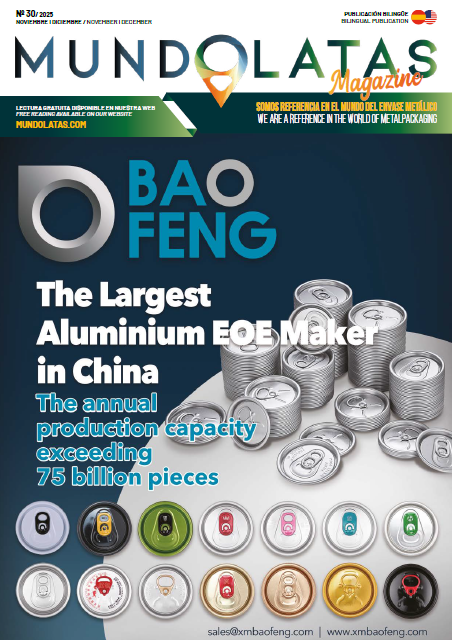| TERM | MEANING |
| ELECTROPHORESIS | Technique used to repair easy-open lids. It consists of submerging them in an electrolytic bath in which is diluted the varnish and pass an electrical current through it. |
| PACKAGING
Packaging |
Element (container) that allows the proper preservation of a product (content), in the case of this glossary refers to any metal container of any shape and size capable of keeping in good condition an article, usually for human consumption. |
| EMBUTITION | Part forming technique (in our case packaging)). A flat sheet of material is subjected to an axial stress that forces it to adapt to the shape of a core or punch. The metal undergoes an elongation in the direction of the grain. |
| ENCERADORA
Gramer Waxer |
See kerosene machine. |
| ENGAGING
Agrafado |
See agrafado. |
| ENGAGING
Agrafado |
See agrafado. |
| ENGOMADORA | Machine that applies the compound or gasket on the inside of the flange of thelid or bottom. |
| ROLLED (OF THE BODY) |
Operation of giving proper shape to the body starting from development plan of the same. The format is a cylinder. |
| ROLLING MACHINE | Machine that performs the windingoperation. It basically consists of a pair of counter-rotating rollers and a bending deflector. It is usually part of a more complex machine (welding machine, agrafadora…) |
| NETTING (OF THE BODY) Reduced |
Decrease in diameter at the lower end of the container that affects both the body and the bottom and allows the stacking of one can on top of the other when the bottom of the first can is inserted into the lid of the second can. |
| PACKAGING
Packaging |
Container or vessel in which certain goods are transported or preserved. In this glossary, when we mention this term we are referring to a metal container. |
| DECOLLAGE” PACKAGING | A type of three-piece container, in which the lid instead of being fixed to the body by means of a closure The traditional one is “glued” to it by means of a tin-lead alloy. This is achieved by providing the body of an inwardly folded flange on which the alloy is applied. The lid ( of the type of flat flange ) is inserted over this flange and is attached to the body by the application of heat, which remelts the alloy. The advantage of these containers is that they can be opened with a small key that is housed in a tab that is part of the lid. Nowadays, this type of packaging is hardly ever used, as it has been replaced by those equipped with easy open lidbut they were the predecessors of them. They also had the problem of an excessive contribution of metal to the product (migration migration). |
| TWO-PIECE PACKAGING | Metal container made from two main components: thebody (forming a single piece with the bottom), and the lid.. They are usually manufactured by the technique of embossing in its different branches. |
| METAL CONTAINER
Canister |
Rigid and watertight container, made to contain food and beverage products. |
| THREE-PIECE PACKAGE | Metal container made of three components: body, bottom and lid. |
| INDUSTRIAL PACKAGING | Packaging used to contain non-food products, such as: paints, varnishes, solvents, etc. Also for oils and fats, food or not. They are generally used for items used in industry or in the home. They are containers that usually do not support a thermal process or maintain a hermetic seal when subjected to internal pressure. They can have different shapes (cylindrical or prismatic) and are usually formed by more than three pieces: Body, bottom, ring, cap, gland, seal, handle, etc. |
| EPOXI (VARNISH) |
Varnish based on epoxy resins. It is characterized by its excellent adhesion to metal and good flexibility although its chemical resistance is poor. For this reason it is often used in combination with resins phenolics that improve the latter. |
| EPOXY-PHENOLIC (VARNISH) |
Varnish obtained by mixing epoxy and phenolic resins . It is characterized by good adhesion to metal, flexibility and chemical resistance. It is the type of varnish of more generalized use. |
| STAIRS (COVER) Gradient |
See gradient. |
| ESCAPE
Leak |
See leakage. |
| ESMALTE
Varnish |
See varnish |
| WHITE ENAMEL
Blancho couché |
See white couché |
| FREE SPACE (CLOSING) |
It is the difference between the thickness of the closure and the sum of the five thicknesses of tinplate that form it (three of the cover and two of the body). |
| THICKNESS (HOJALATA) Tinplate thickness |
Tinplatesheet thickness. Practically matches that of steel base of it. |
| SEAL THICKNESS (CLOSING) |
Maximum dimension of the closure measured perpendicular to the axis of the container. In it are contained the five layers of tinplate from lock. |
| STAMPING
Coding |
Marking an engraving in relief on a surface. In case of being carried out in a part of the packagingis usually on the bottom ó lid of the same. This imprint is usually a legal text or a trademark or anagram. |
| STAMPING
Engraving |
See engraving. |
| TINNING
Coating |
See coating. |
| STYLER | Machine that applies a molten tin-lead alloy on a tinplate surface. A typical case is the equipment used in the manufacture of decollage type containers in which the flange on the side of the lid is impregnated with the alloy by passing over a series of rotating rollers aligned and immersed in a bath of the same. |
| ALLOYED TINNAM | Tin-iron alloy zone between the base steel and the free tin layer in the tin plate. Its thickness is very small, in the order of 100 nm, and favors the weldability in the manufacturing process of the packaging. |
| FREE STANNUM | This is the tin layer in tinplate located between the passivation (outer) layer and the alloyed tin layer. (inside). It is made of pure tin and its thickness is in the order of 400 nm. Guarantees the service life of the tinplate . |
| STERILIZATION
Appertization |
Process of disinfection of food, usually achieved by heat treatment in the case of canned food. See autoclaving. |
| STERILIZER
Autoclave Processor |
See autoclave. |
| DRYING STOVE
Drying oven |
See drying oven. |
| STUFFING
Curing |
See cured. |
| EXPANSION | Machine that starts from bodies of cylindrical containers, transforms them into rectangular or other non-cylindrical shapes. The way it works is based on the application of an expansion force (from the inside out) to the metal such that the elastic limit of the metal is exceeded, thus deforming it permanently. So that the side seam of the body to withstand this stress must be made by electric welding. |
| EXPLOSIMETER | Portable or fixed safety equipment used in lithography furnaces. to prevent possible explosions due to accumulation of flammable gases. Its working principle is to cause controlled mini-explosions, warning of their existence if the atmosphere of the furnace presents a risk of accident by deflagration. |
| METAL EXHIBITION | This designates the value expressed in some unit of measurement (usually in milliamps of electric current that allow to pass) of the tiny areas of the inner surface of a packaging that have not been well protected in the varnishing operation. varnishingand the metal is therefore exposed to an attack by the |
| EXPULSIONS OF SOL- DADURA |
Very fine spines of molten metal that can occur at the edges of the electric weld of theside seam of a container.They are caused by excessive welding pressure. Generate metal exposure on varnished containers. |
| EXPELLER (CLOSER) |
In a seamer, this is the name given to the part located in the center of the mandrel and which, by an alternating movement in the direction of the container axis , dislodges the container from the mandrel once the closing operation has been completed , and can be adjusted in height and pressure. |
| EXPELLER (TROQUEL) Button |
See ejector. |
| DRY EXTRACT | Solid residue remaining after removal – usually by heat – of the liquid components of a product. Concept widely used in the application of varnishes and composites, since it represents the useful part of them. |
| EYECTOR (TROQUEL) Button |
Punch part (upper part of the diemounted on the press carriage) that removes the part from the inside of the tool once it has been made. |




